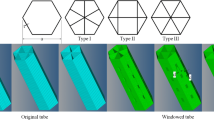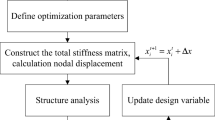Abstract
Multi-cell thin-walled structures exhibit significant advantages in maximizing energy absorption and minimizing mass during vehicle crashes. Since the topological distribution of wall members has an appreciable effect on the crashworthiness, their design signifies an important area of research. As a major energy absorber, multi-cell tubes are more commonly encounter oblique loading in real life. Thus, this study aimed to optimize multi-cell cross-sectional configuration of tubal structures for multiple oblique loading cases. An integer coded genetic algorithm (ICGA) is introduced here to optimize topological distribution of multi-celled web members for single/multiple oblique impacting conditions. Specifically, material distribution in a form of allocating web wall thickness, starting from zero, is considered as design variables and maximization of energy absorption (EA) as the design objective under the predefined peak crushing force and structural mass constraints. The optimization allows generating uniform or non-uniform thickness distribution in different web wall configurations to maximize usage efficiency of material. Compared with the baseline structure, the optimized configurations largely improved the energy absorption in both single and multiple load cases. The examples demonstrate that the proposed ICGA-based design method not only provides a useful approach to searching for novel crashworthy structures in a systematic fashion, but also develops a series of novel multi-cell topologies for multiple oblique loading cases.






















Similar content being viewed by others
References
Alavi Nia A, Parsapour M (2014) Comparative analysis of energy absorption capacity of simple and multi-cell thin-walled tubes with triangular, square, hexagonal and octagonal sections. Thin-Walled Struct 74:155–165
Amjady N, Shirzadi A (2009) Unit commitment using a new integer coded genetic algorithm. Eur. Trans. Electr. Power 19:1161–1176
Asanjarani A, Dibajian SH, Mahdian A (2017) Multi-objective crashworthiness optimization of tapered thin-walled square tubes with indentations. Thin-Walled Struct 116:26–36
Bandi P, Schmiedeler JP, Tovar A (2013) Design of Crashworthy Structures With Controlled Energy Absorption in the Hybrid Cellular Automaton Framework. J Mech Des 135:091002-091002-091011
Bendsøe MP, Kikuchi N (1988) Generating optimal topologies in structural design using a homogenization method. Comput Methods Appl Mech Eng 71:197–224
Bendsoe MP, Sigmund O (2013) Topology optimization: theory, methods, and applications, Springer Science & Business Media
Chapman CD, Saitou K, Jakiela MJ (1994) Genetic algorithms as an approach to configuration and topology design. J Mech Des 116:1005–1012
Chen S-Y, Shui X-F, Huang H (2016) Improved genetic algorithm with two-level approximation using shape sensitivities for truss layout optimization. Struct Multidiscip Optim 55:1365–1382
Curt MC, Horvath D (2012) Future Material Opportunities and Direction for Lightweighting Automotive Body Structure, in, <http://www.nist.gov/mml/acmd/structural_materials/upload/Future-Material-Opportunities-and-Direction-for-Lighweighting-Automotive-v-Final-v2.pdf> 2012
Duan X, Qin X, Li F (2016) Topology optimization of Stokes flow using an implicit coupled level set method. Appl Math Model 40:5431–5441
Duddeck F, Hunkeler S, Lozano P, Wehrle E, Zeng D (2016) Topology optimization for crashworthiness of thin-walled structures under axial impact using hybrid cellular automata. Struct Multidiscip Optim 54:415–428
Fang J, Gao Y, Sun G, Qiu N, Li Q (2015a) On design of multi-cell tubes under axial and oblique impact loads. Thin-Walled Struct 95:115–126
Fang J, Gao Y, Sun G, Zheng G, Li Q (2015b) Dynamic crashing behavior of new extrudable multi-cell tubes with a functionally graded thickness. Int J Mech Sci 103:63–73
Fang J, Sun G, Qiu N, Steven G, Li Q (2017a) Topology optimization of multi-cell tubes under out-of-plane crushing using a heuristic artificial bee colony (ABC) algorithm. ASME Transactions . J Mech Des 139(7):071403
Fang J, Sun G, Qiu N, Kim NH, Li Q (2017b) On design optimization for structural crashworthiness and its state of the art. Struct Multidiscip Optim 55:1091–1119
Forsberg J, Nilsson L (2007) Topology optimization in crashworthiness design. Struct Multidiscip Optim 33:1–12
Goel MD, Matsagar VA, Gupta AK (2015) Blast resistance of stiffened sandwich panels with aluminum cenosphere syntactic foam. Int. J. Impact Eng. 77:134–146
Goldberg DE (1989), Genetic algorithms in search optimization and machine learning, Addison-wesley Reading Menlo Park
Han DC, Park SH (1999) Collapse behavior of square thin-walled columns subjected to oblique loads. Thin-Walled Struct 35:167–184
Huang X, Xie Y, Lu G (2007) Topology optimization of energy-absorbing structures. Int. J. Crashworthiness 12:663–675
Jakiela MJ, Chapman C, Duda J, Adewuya A, Saitou K (2000) Continuum structural topology design with genetic algorithms. Comput Methods Appl Mech Eng 186:339–356
Jang HH, Lee HA, Lee JY, Park GJ (2012) Dynamic Response Topology Optimization in the Time Domain Using Equivalent Static Loads. AIAA J 50:226–234
Song JC, Zhao L, Liu HY (2008) Optimizing cooperative control based on genetic algorithm for electroSlag remelting process, in: 2008 I.E. Conference on Cybernetics and Intelligent Systems, 1216–1219
Lee H-A, Park G-J (2015) Nonlinear dynamic response topology optimization using the equivalent static loads method. Comput Methods Appl Mech Eng 283:956–970
Li Q Li, Steven G, Xie Y (2001) Evolutionary structural optimization for connection topology design of multi-component systems. Eng Comp 18(3/4):460–479
Lipowski A, Lipowska D (2012) Roulette-wheel selection via stochastic acceptance. Physica A: Statistical Mechanics and its Applications 391:2193–2196
Mahmoodi A, Shojaeefard MH, Saeidi Googarchin H (2016) Theoretical development and numerical investigation on energy absorption behavior of tapered multi-cell tubes. Thin-Walled Struct 102:98–110
Marzbanrad J, Ebrahimi MR (2011) Multi-Objective Optimization of aluminum hollow tubes for vehicle crash energy absorption using a genetic algorithm and neural networks. Thin-Walled Struct 49:1605–1615
Mayer RR, Kikuchi N, Scott RA (1996) Application of topological optimization techniques to structueal crashworthiness. Int J Numer Methods Eng 39:1383–1403
Morales AK, Quezada CV (1998) A universal eclectic genetic algorithm for constrained optimization, in: Proceedings of the 6th European congress on intelligent techniques and soft computing, Citeseer, 518–522
Neubauer A (1997) The circular schema theorem for genetic algorithms and two-point crossover, in: Genetic Algorithms in Engineering Systems: Innovations and Applications, 1997. GALESIA 97. Second International Conference On (Conf. Publ. No. 446), IET, 209–214
NHTSA-US NCAP (2011) in, <http://www.safecarguide.com/exp/usncap/usncap.htm>
Ortmann C, Schumacher A (2013) Graph and heuristic based topology optimization of crash loaded structures. Struct Multidiscip Optim 47:839–854
Pedersen CBW (2003) Topology optimization for crashworthiness of frame structures. Int. J. Crashworthiness 8:29–39
Pedersen CBW (2004) Crashworthiness design of transient frame structures using topology optimization. Comput Methods Appl Mech Eng 193:653–678
Pu Y, Shi Y, Zhang T (2012) A superiority inheritance based method to search the ambiguity function main ridge slice of radar emitter signals, in: 2012 I.E. International Conference on Information Science and Technology, 806–809
Qi C, Yang S (2014) Crashworthiness and lightweight optimisation of thin-walled conical tubes subjectedto an oblique impact. Int. J. Crashworthiness 19:334–351
Qi C, Yang S, Dong F (2012) Crushing analysis and multiobjective crashworthiness optimization of tapered square tubes under oblique impact loading. Thin-Walled Struct 59:103–119
Qiu N, Gao Y, Fang J, Feng Z, Sun G, Li Q (2015) Crashworthiness analysis and design of multi-cell hexagonal columns under multiple loading cases. Finite Elem Anal Des 104:89–101
Qiu N, Gao Y, Fang J, Sun G, Kim NH (2018) Topological Design of multi-cell hexagonal tubes under axial and lateral loading cases using a modified particle swarm algorithm, Applied Mathematical Modelling 53:567–583
Reyes A, Langseth M, Hopperstad O (2003) Square aluminum tubes subjected to oblique loading. Int. J. Impact Eng. 28:1077–1106
Sigmund O (2014) A 99 line topology optimization code written in Matlab. Struct Multidiscip Optim 21:120–127
Song J, Guo F (2013) A comparative study on the windowed and multi-cell square tubes under axial and oblique loading. Thin-Walled Struct 66:9–14
Soto C (2004) Structural topology optimization for crashworthiness. Int. J. Crashworthiness 9:277–283
Sun G, Xu F, Li G, Li Q (2014) Crashing analysis and multiobjective optimization for thin-walled structures with functionally graded thickness. Int. J. Impact Eng. 64:62–74
Sun G, Pang T, Fang J, Li G, Li Q (2017) Parameterization of criss-cross configurations for multiobjective crashworthiness optimization. Int J Mech Sci 124-125:145–157
Tabacu S (2015) Axial crushing of circular structures with rectangular multi-cell insert. Thin-Walled Struct 95:297–309
Tang Z, Liu S, Zhang Z (2013) Analysis of energy absorption characteristics of cylindrical multi-cell columns. Thin-Walled Struct 62:75–84
Toğan V, Daloğlu AT (2008) An improved genetic algorithm with initial population strategy and self-adaptive member grouping. Comput Struct 86:1204–1218
Wang MY, Wang X, Guo D (2003) A level set method for structural topology optimization. Comput Methods Appl Mech Eng 192:227–246
Woon SY, Tong L, Querin OM, Steven GP (2005) Effective optimisation of continuum topologies through a multi-GA system. Comput Methods Appl Mech Eng 194:3416–3437
Wu S, Zheng G, Sun G, Liu Q, Li G, Li Q (2016) On design of multi-cell thin-wall structures for crashworthiness. Int. J. Impact Eng. 88:102–117
Wu S, Sun G, Wu X, Li G, Li Q (2017) Crashworthiness analysis and optimization of fourier varying section tubes. Int. J. Non Linear Mech. 92:41–58
Xie Y, Steven GP (1993) A simple evolutionary procedure for structural optimization. Comput Struct 49:885–896
Yang S, Qi C (2013) Multiobjective optimization for empty and foam-filled square columns under oblique impact loading. Int. J. Impact Eng. 54:177–191
Yin H, Xiao Y, Wen G, Qing Q, Wu X (2015) Crushing analysis and multi-objective optimization design for bionic thin-walled structure. Mater Des 87:825–834
Zeng D, Duddeck F (2017) Improved hybrid cellular automata for crashworthiness optimization of thin-walled structures. Struct Multidiscip Optim 56:101–115
Zhang X, Zhang H (2012) Numerical and theoretical studies on energy absorption of three-panel angle elements. Int. J. Impact Eng. 46:23–40
Zhang X, Zhang H (2014) Axial crushing of circular multi-cell columns. Int. J. Impact Eng. 65:110–125
Zhang X, Wen Z, Zhang H (2014) Axial crushing and optimal design of square tubes with graded thickness. Thin-Walled Struct 84:263–274
Zhou P, Du J, Lü Z (2017) Interval analysis based robust truss optimization with continuous and discrete variables using mix-coded genetic algorithm. Struct Multidiscip Optim 56:353–370
Acknowledgements
This work is supported by National Natural Science Foundation of China (51575172). The first author Dr. Guangyong Sun is a recipient of Australian Research Council (ARC) Discovery Early Career Researcher Award (DECRA). The third author Dr. Jianguang Fang is a recipient of University of Technology Sydney (UTS) Chancellor’s Postdoctoral Research Fellowship.
Author information
Authors and Affiliations
Corresponding author
Rights and permissions
About this article
Cite this article
Sun, G., Liu, T., Fang, J. et al. Configurational optimization of multi-cell topologies for multiple oblique loads. Struct Multidisc Optim 57, 469–488 (2018). https://doi.org/10.1007/s00158-017-1839-5
Received:
Revised:
Accepted:
Published:
Issue Date:
DOI: https://doi.org/10.1007/s00158-017-1839-5




